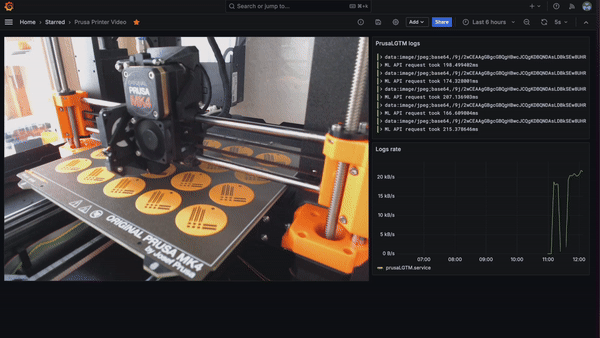This helps monitor your Prusa printer by taking regular screenshots and storing them in Loki. This lets you visualise your prints in Grafana.
- A Linux Machine
- WebCam pointing at your printer
- Ability to send logs to Loki (see: https://grafana.com/docs/loki/latest/send-data/)
- (optional) Your linux user that is part of the
videogroup. If not, run it with sudo.
Please find the right binary for your device here: https://github.com/gouthamve/prusaLGTM/releases/latest
./prusaLGTM print-image
This should now start logging the image to stdout.
Usage: prusaLGTM print-image [flags]
Print images from a camera to stdout.
Flags:
-h, --help Show context-sensitive help.
--prometheus-port=8366 The port to expose Prometheus metrics on.
--max-log-size=256000 Maximum bytes of the image to be logged. Set it to lower than Loki log line limit
--max-image-size=1080 Maximum size of the image to be logged in pixels.
--prusa-link-url= The URL to PrusaLink. When provided we only log images when there is a print job ongoing.
--ml-api-url=STRING EXPERIMENTAL: The URL to the ML API to detect failures.
--camera-device="/dev/video0" The video device to use.
--format=FORMAT
--camera-frame-width=2304 The width of the frame.
--camera-frame-height=1536 The height of the frame.
--camera-frame-rate=2.0 The frame rate of the camera.
--camera-picture-interval=10s The interval at which to take pictures.
Usage: prusaLGTM generate-timelapse --loki-url=STRING --start-time=TIME --end-time=TIME [flags]
Generate a timelapse video from the print images.
Flags:
-h, --help Show context-sensitive help.
--prometheus-port=8366 The port to expose Prometheus metrics on.
--loki-url=STRING The URL to the Loki API to fetch logs from.
--loki-username=STRING The username to authenticate with the Loki API.
--loki-password=STRING The password to authenticate with the Loki API.
--logql-query="{unit=\"prusaLGTM.service\"} |= \"base64\"" The LogQL query to fetch logs.
--start-time=TIME The start time of the logs to fetch.
--end-time=TIME The end time of the logs to fetch.
--encode-to-mp4 Whether to encode the timelapse to MP4. Requires ffmpeg
--output-path="videos/" The path to save the timelapse video.
